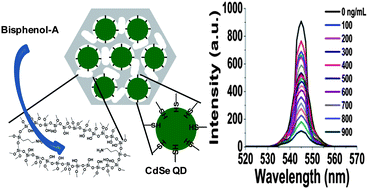CdSe quantum dot-encapsulated molecularly imprinted mesoporous silica particles for fluorescent sensing of bisphenol A
Abstract
We prepared a highly sensitive molecularly imprinted fluorescent sensor by using a CdSe

* Corresponding authors
a
Department of Materials Science and Engineering, College of Engineering, Seoul National Univeristy, Seoul 151-744, Korea
E-mail:
jichang@snu.ac.kr
Fax: +82-2-885-1748
Tel: +82-2-880-7190
We prepared a highly sensitive molecularly imprinted fluorescent sensor by using a CdSe

 Please wait while we load your content...
Something went wrong. Try again?
Please wait while we load your content...
Something went wrong. Try again?
Y. Kim, J. B. Jeon and J. Y. Chang, J. Mater. Chem., 2012, 22, 24075 DOI: 10.1039/C2JM34798A
To request permission to reproduce material from this article, please go to the Copyright Clearance Center request page.
If you are an author contributing to an RSC publication, you do not need to request permission provided correct acknowledgement is given.
If you are the author of this article, you do not need to request permission to reproduce figures and diagrams provided correct acknowledgement is given. If you want to reproduce the whole article in a third-party publication (excluding your thesis/dissertation for which permission is not required) please go to the Copyright Clearance Center request page.
Read more about how to correctly acknowledge RSC content.
 Fetching data from CrossRef.
Fetching data from CrossRef.
This may take some time to load.
Loading related content
